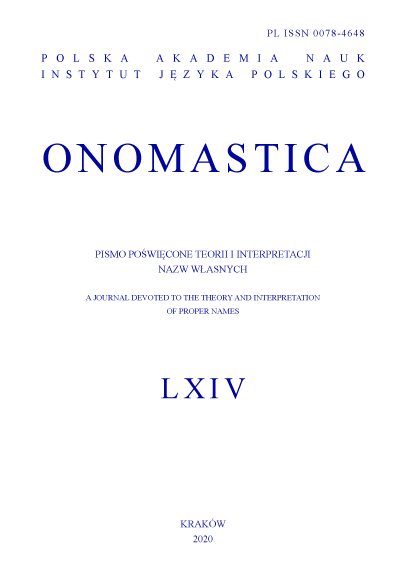Abstract
The aim of this paper is to discuss selected formal and pragmatic aspects of the Austro-Hungarian military name policy in the last quarter of the 19th and in the early 20th century. In the introductory section the proprial status of the names of military units (which constitute a part of military chrematonymy) is discussed. An attempt is made to outline the location of these names on the classifi-catory map of chrematonomastics as well. A brief discussion of the historical and terminological background of the Austro-Hungarian military unit names follows. The most important concepts of the theory of name and naming policy are outlined. The presentation of the analysed onymic mate-rial covers unit names included in the officer lists (Schematismen) of the Austro-Hungarian forces as well as names present in the paper seals (Verschlussmarken). On the basis of the material, polymorphism of the discussed names is shown in the sense that obligatory and facultative elements of the names may appear in different ways and within various syntactic name models, depending on the context (including continuous text within which a name is used). Two main syntactic models of the discussed names are proposed. The orthographic and syntactic rules of unit numbering and the ways of embedding geographical names and names of patrons and honorary regiment owners (Inhaber) into unit names are outlined. The meaning and spelling of the expressions imperial-royal (k.k. = kaiserlich-königlich) and imperial and royal (k.u.k. = kaiserlich und königlich) are explained.
References
Bator, J. (2005). Wojna galicyjska [War in Galizien]. Kraków: Libron.
Breza, E. (1998). Nazwy obiektów i instytucji związanych z nowoczesną cywilizacją (chrematonimy) [Names of objects and institutions related to the modern civilisation]. W: E. Rzetelska-Feleszko (red.), Polskie nazwy własne. Encyklopedia [Polish proper names. Encyclopedia] (s. 343–361). Warszawa–Kraków: Towarzystwo Naukowe Warszawskie — Instytut Języka Polskiego PAN.
Dunaj, B. (2007). Teoretyczne problemy onomastyki sportowej. Sposoby identyfikacji klubów [Theoretical aspects of the onomastics of sports. Ways of identifying sport clubs]. W: A. Cieślikowa, B. Czopek-Kopciuch, K. Skowronek (red.), Nowe nazwy własne. Nowe tendencje badawcze [New proper names. New research trends] (s. 489–494). Kraków: PANDIT.
Gałkowski, A. (2007). Socjoideonimy a chrematonimy — miejsce nazw organizacji i inicjatyw społecznych w dynamice onimicznej języka [Socioideonyms and chrematonyms — the status of the names of social organisations and activities in the onymic dynamics of the language]. W: A. Cieślikowa, B. Czopek-Kopciuch, K. Skowronek (red.), Nowe nazwy własne. Nowe tendencje badawcze [New proper names. New research trends] (s. 495–508). Kraków: PANDIT.
Gałkowski, A. (2011). Chrematonimy w funkcji kulturowo-użytkowej. Onomastyczne studium porównawcze na materiale polskim, włoskim i francuskim [Chrematonyms in the cultural-functional context. An onomastic comparative study based on Polish, Italian and French resources]. Wyd. 2. Łódź: Wydawnictwo Uniwersytetu Łódzkiego.
Górnowicz, H. (1979). Nazwy własne polskich jednostek wojskowych [Proper names of Polish military units]. Poradnik Językowy, 8, 369–386.
Karamańska, M. i Młynarczyk, E. (2018). Językowy obraz troski o II Rzeczpospolitą utrwalony w nazwach stowarzyszeń [A linguistic image of concern over the Second Polish Republic as preserved in association names]. Annales Universitatis Paedagogicae Cracoviensis. Studia Linguistica, 13, 13–24.
Karamańska, M. i Młynarczyk, E. (2019). Komponenty eksponujące cechę żeńskości w nazwach stowarzyszeń II Rzeczpospolitej [Components exposing the feminine quality in the names of associations in the Second Polish Republic]. Annales Universitatis Paedagogicae Cracoviensis. Studia Linguistica, 14, 67–78.
Kosyl, Cz. (1993). Chrematonimy [Chrematonyms]. W: J. Bartmiński (red.), Współczesny język polski. Encyklopedia kultury polskiej [The modern Polish language. An encyclopaedia of Polish culture] (t. 2, s. 440–444). Wrocław: Wiedza o Kulturze.
Kucała, M. (1967). Co już jest, a co jeszcze nie jest nazwą własną [What is already a proper name and what is not]. Onomastica, 12, 153–161.
Kułakowska, M. (2018). Nazwy bractw rycerskich jako element budowania wizerunku grupy rekonstrukcyjnej [The names of the brotherhoods of knights as a building block in the image of a historical reenactment group]. Słowo. Studia językoznawcze, 9, 68–83.
Lubaś, W. (1983). Próba socjolingwistycznej definicji nazwy terenowej [An attempt at creating sociolinguistic definition of a name of uninhabited geographical feature]. W: K. Rymut (red.), Geografia nazewnicza [Geography of names and naming] (s. 19–26). Wrocław–Warszawa–Kraków–Gdańsk–Łódź: Zakład Narodowy im. Ossolińskich.
Młynarczyk, E. (2019). Tendencje nazwotwórcze w chrematonimii społecznościowej II Rzeczypospolitej (na przykładzie nazw stowarzyszeń) [Trends related to the creation of names in the social chrematonymy of the Second Polish Republic (based on the names of associations)]. Onomastica, 63, 209–226.
Nowakowski, T. (1992). Armia Austro-Węgierska [The Austro-Hungarian Army]. Warszawa: FENIX.
Włoskowicz, W. (2015). Trójelementowy model znaczenia onimicznego i pojęciowy model onomastykonu [The triple model of onymic meaning and the conceptual model of onomasticon]. Onomastica, 59, 57–76.


